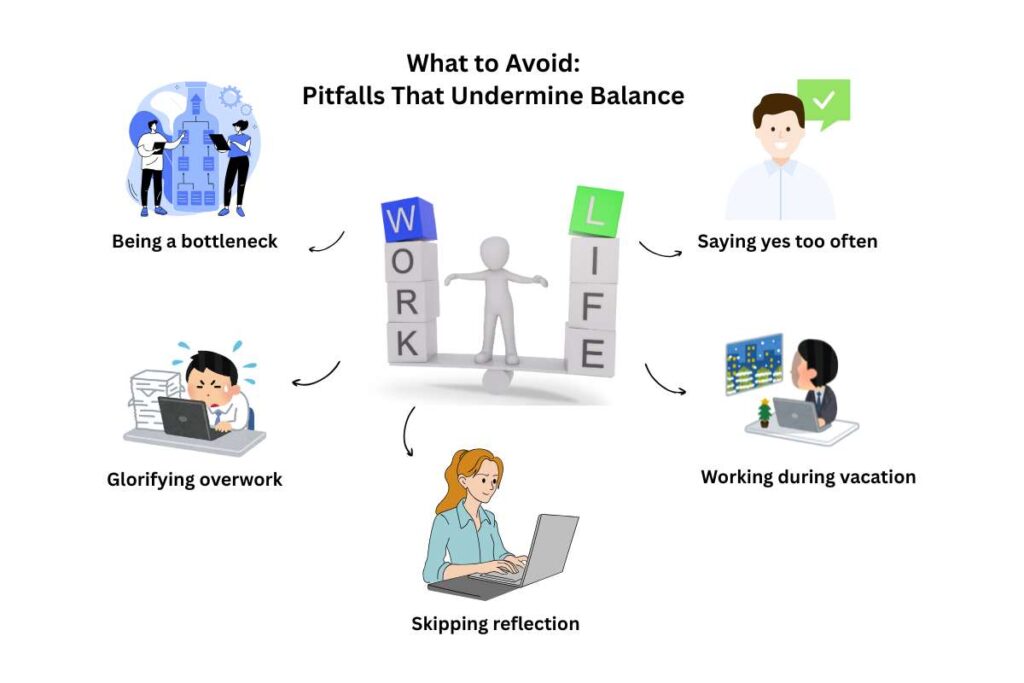The job of a Chief Information Officer has changed completely in the last decade. The job has gone way beyond just sorting out server issues or handling IT budgets. CIOs are expected to drive innovation, build secure digital ecosystems, support hybrid work models, and lead teams across time zones, all while staying sane. These leaders are under greater pressure than ever to innovate, safeguard critical assets, and orchestrate complex, global operations. Many do face a substantial workload and stress as part of this evolution.
Naturally, this constant demand takes a toll, and many leaders struggle to carve out a personal life. Even simple things, like dinner with family or a weekend without notifications, start to feel out of reach. Learning to find and maintain balance is a skill that makes you a better decision-maker and leader. The following work-life balance strategies for CIOs are practical, honest, and designed for today’s reality of overwork.
15 Work-Life Balance Strategies for CIOs Who Never Log Off
1. Protect Your Time Like You Protect Your Data
Personal time doesn’t magically appear; you must make space for it. Schedule it like you would a leadership huddle or vendor review. Add blocks to your calendar for walking your dog, cooking, exercising, or sitting with a book. These are essentials.
When you consistently defend your non-work time, you remind yourself (and your team) that you’re not just a title. You’re a human being who needs fuel, not a server that runs 24/7. The more consistent you are, the easier it becomes to stay grounded, even on busy days.
2. Set Boundaries Clearly
Leadership doesn’t require being constantly available. One of the strongest Work-Life Balance Strategies for CIOs professionals is setting boundaries and sticking to them. Set your “offline” hours and let your team know. For example, no email after 7 p.m., or blocking mornings for deep work.
Boundaries reduce decision fatigue and give everyone clarity on how you work. It’s not like you are avoiding responsibility. Think of it like you’re safeguarding your attention span. When you’re clear about your limits, your team becomes more self-sufficient. That independence is suitable for everyone.
3. Cut the Meeting Fat
Meetings multiply fast, and most of them don’t need to happen. Audit your calendar. Ask yourself: “Was I needed in that one?” Cancel or decline anything you can delegate or replace with a quick update. Then block off daily “no-meeting” time to think, breathe, and lead.
You don’t need an open calendar to prove you’re doing the work. The best CIOs guard their time so they can be present for what matters: people, planning, and big-picture decisions.
4. Delegate Like You Trust Your Team

If you’re holding onto tasks because “no one else can do it right,” you’re holding your balance hostage. Trust your team to step up. Delegation is one of the core work-life balance strategies for CIO professionals, not because it’s easy, but because it’s necessary.
Let your team take ownership. Mistakes may happen, but they’re part of learning. As you step back from the weeds, you’ll find more room to focus on strategy and mental clarity, and your team will become stronger in the process.
5. Take a Pause After Every Big Push
It takes time to recover after a major project launch, migration, or integration. Even a single day offline can reset your energy. You’re not a robot. If you don’t pause, the pressure builds until something breaks.
You don’t need a two-week vacation every time. Just a short break where you’re not in problem-solving mode. That recovery makes you more focused and less reactive in the following days. Think of it as post-launch maintenance for your mind.
6. Work-Life Balance Strategies for CIOs Start at Home
CIOs who succeed professionally don’t ignore their families. They’re present. They show up. They put down the phone at dinner and make it to their kids’ events. And when they miss something? They make up for it with intention.
These moments build emotional strength. When your home life is solid, your leadership is steadier. Don’t treat family time like a luxury. Make it a non-negotiable part of your week. It’s one of the most honest strategies for CIO leaders to live by.
7. Don’t Celebrate Hustle, Celebrate Health
Sending emails at 2 a.m. is a red flag. It leads to excess burnout, which is not something you should be proud of. Great CIOs prioritize consistent, clear-headed performance, not exhaustion.
If something can wait, let it stay. Teach your team to do the same. When leadership slows down, everyone else follows. Make sustainability the standard, not overworking. The long game matters more than daily output.
8. Learn To Say “No”
Every week brings new asks, so join this meeting, review that proposal, and weigh in on this roadmap. But not every task needs your attention. Learning to say no (without guilt) is a key leadership skill.
Protect your bandwidth for high-impact work. Say no to distractions that dilute your focus. The CIOs who get ahead are the ones who spend their energy wisely, not the ones who say yes to everything. This is one of the clearest Work-Life Balance Strategies for CIOs efficiency and mental clarity.
9. Have Device-Free Zones (And Stick to Them)
Create sacred time without screens, like during meals, evenings, or the first hour of your day. No Slack, no email, no scrolling. These windows let your nervous system reset and your attention return.
Technology overload keeps your brain in reactive mode. Device-free time is crucial for a good mental headspace. Try it for a week. You’ll feel the difference in your focus, sleep, and mood.
10. Show Your Team What Balance Looks Like

If you say “balance matters,” but you’re online all weekend, your team won’t believe you. Actions lead culture. They’ll follow your lead if you protect your boundaries, take breaks, and they’ll connect sometimes.
This is one of the most powerful Work-Life Balance Strategies for CIOs and managers. Leading by example builds a healthier team. It also sets expectations that long-term success doesn’t require long-term burnout.
11. Reflect on Your Time Like a Budget
Each month, review your calendar and assess: What helped? What drained me? What was a waste? Then start cutting.
Just like budgeting money, you need to budget your time. CIOs who reflect regularly make smarter adjustments and stay aligned with what matters, minor cuts, one meeting here, one useless task there, free up big mental space.
12. Talk to Someone Who Gets It
You don’t have to carry the weight alone. Talk to a coach, therapist, or mentor who understands executive life. They’re not there to “fix “you but to help you see clearly.
This is a quieter but most powerful Work-Life Balance Strategies for CIOs professionals. You’ll make better decisions, reduce isolation, and stop second-guessing every step when you have space to process openly.
13. Build Systems That Don’t Rely on
Too many CIOs are central to everything, from approvals to troubleshooting. But when you’re the byou’reeck, your time disappears. Create systems and processes that allow your team to function independently.
Train team leads. Automate what you can. Document everything. Over time, this reduces your day-to-day load and gives you freedom to step back, whether for an afternoon or an actual vacation.
14. Make Rest and Recovery a Team Value
Talk openly about time off. Celebrate when someone sets boundaries. Encourage the team to step away, recharge, and return with energy.
This cultural shift pays off. You’ll see morale, better work, and stronger loyalty. One of the underrated Work-Life Balance Strategies for CIOs departments is normalizing wellness not just for you, but for everyone who works with you.
15. Don’t Just F Don’turself, Fix the Environment
If your team is overloaded, it spills over to you. Fixing balance isn’t just self-care. The whole organization must stay on the same tangent. Encourage smarter working hours, “quiet Fridays,” or flexible schedules.
Healthy leadership systems create healthy leaders. And when the whole team is balanced, you’ll feel like you’re not pushing upstream alone.

Achieving Harmony: A Comprehensive Guide to Work-Life Balance
Here are 8 Strategies for Achieving Work-Life Balance: 1. Set Boundaries 2. Prioritize Tasks 3. Practice Time Management 4. Take Regular Breaks 5. Maintain Healthy Habits 6. Communicate Effectively
Case Study: The CIO Who Reclaimed Weekends
Gary Baxter, CIO and Vice President of Maine Employers’ Mutual Insurance Co. (MEMIC), faced constant meetings and after‑hours demands. To reclaim balance, he treated family time as a critical appointment. Baxter explained:
“It sounds cold, but you really do have to schedule time with your family … I have appointments with my wife and kids. And I would no more miss that time … than a performance evaluation with my boss.”
What he did: He built personal time into his calendar, dinners, weekend rest, and even outdoor activities were non‑negotiable. He communicated this openly, modeling balance for his team.
Outcome: Energy improved, fewer late-night emails, and a culture shift where others started valuing downtime. Scheduling life like work was one of the most effective Work‑Life Balance Strategies for CIO leaders can adopt.
Popular CIO Quotes
These quotes reflect the truth behind the Work-Life Balance Strategies for CIOs roles: You lead better when you’re well-rested, self-aware, and focused.
→ Tariq Khan, VP of IT: “Your inbox is your to-do list, but it’s owned by other people. You need your own.”
→ Kevin Nally, CIO, U.S. Secret Service: “I have adjusted my work day to meet the needs of my family … I depart work no later than 5:30 p.m. – period. Once home, I give [my son] a bath and prepare dinner … We dine together as a family – very important.” — Commitment to daily rituals shows how boundary-setting and family focus serve as core leadership practices.
→ Jason James, CIO, Optima Healthcare Solutions: “I set boundaries and communicate those boundaries … One boundary: I am completely out of the office when vacationing. … setting boundaries allows you to find harmony with both work and family.” — Emphasizes vocal enforcement of time off and personal limits.
What to Avoid: Pitfalls That Undermine Balance

- Being a bottleneck: If all decisions flow through you, you’ll never log off. Empower your team.
- Glorifying overwork: Responding to emails at midnight isn’t dedication, it’s disorganization.
- Saying yes too often: Not every decision needs your input. Protect your decision-making energy.
- Working during vacation: If you can’t switch off, your team thinks they shouldn’t either.
- Skipping reflection: Without regular check-ins, bad habits creep in silently.
Conclusion
These Work-Life Balance Strategies for CIOs professionals are not fluffy ideas. However, each
offers a different lens to protect your time, energy, and focus. Small changes, whether blocking calendar space, limiting meetings, or unplugging at night, add up.
Balance isn’t the opposite of ambition; it’s what suits it. As CIOs take on broader responsibilities, the ability to step back becomes just as necessary as stepping up. Implement these strategies intentionally and consistently. Your health, leadership, and team will all be better for it.


















